DfT's gender pay gap report 2017
Published 18 December 2017
Context
Earlier this year, the government introduced world-leading legislation that made it statutory for organisations with 250 or more employees to report annually on their gender pay gap. Government departments are covered by the Equality Act 2010 (Specific Duties and Public Authorities) Regulations 2017 which came into force on 31 March 2017. These regulations underpin the Public Sector Equality Duty and require the relevant organisations to publish their gender pay gap data by 30 March 2018 and then annually, including the:
- mean and median gender pay gaps
- mean and median gender bonus gaps
- proportion of men and women who received bonuses
- proportions of male and female employees in each pay quartile
The gender pay gap shows the difference in the average pay between all men and women in a workforce. If a workforce has a particularly high gender pay gap, this can indicate there may be a number of issues to deal with, and the individual calculations may help to identify what those issues are.
The gender pay gap is different to equal pay. Equal pay deals with the pay differences between men and women who carry out the same jobs, similar jobs or work of equal value. It is unlawful to pay people unequally because they are a man or a woman.
The Department for Transport supports the fair treatment and reward of all staff irrespective of gender.
This report fulfils the department’s reporting requirements, analyses the figures in more detail and sets out what we are doing to close the gender pay gap in the organisation.
Introduction by Bernadette Kelly, Permanent Secretary at the Department for Transport
Transport connects everyone. It’s integral to people’s lives, gets people to work, supports city growth and connects us internationally. The transport sector is a major sector for the economy and a significant employer: nearly 5% of the workforce is in transport-related industries.
The government is investing to make journeys simpler, faster and more reliable to support jobs, enable business growth and bring our country closer together. DfT is at the heart of the transport system and we aim to reflect the people and communities we serve. We are committed to diversity, inclusion and gender balance across the department, and giving all our employees opportunities to develop and progress.
In DfT, we have a mean gender pay gap of 16.9%. While this is higher than some other government departments, we’re confident it isn’t a pay issue – there is equal treatment for work of equal or similar value.
The transport sector has been a very male dominated environment. There is a disproportionate representation of men due to the technical, engineering, construction and maritime skills required and lower proportions of female students in STEM subjects leading into those careers. We are still living with the vestiges of that culture, with women representing 20% of the transport industry as a whole. For example, in 2016, women represented just 20% of the rail industry, and only 4.4% of railway engineering, while the entire UK engineering workforce is 91% male .
Although there are currently a larger proportion of female employees in our lower graded roles, we have been working hard to encourage more women to consider careers in the department and within our wider transport sector. To support gender equality we train our staff in recognising and mitigating unconscious bias; we have introduced name blind recruitment and diverse recruitment panels; provide flexible working and have 4 active gender networks across the department and its agencies. Our work on promoting gender equality has led to the department being featured in the Times Top 50 Employers for Women for the first time ever. We were also proud to jointly host major events in London and Cardiff for International Women’s Day 2017.
In 2016 we published the Transport infrastructure skills strategy (TISS) to create a shared approach to addressing the UK’s transport sector skills shortages by harnessing the power of apprenticeships. 35,000 apprenticeships are needed across the industry to 2022 – a figure which is only achievable if we can tap into the widest possible talent pool. That needs to change, which is why the TISS includes a commitment to gender parity in technical apprenticeships by 2030. In 2018, we have the Year of Engineering, a DfT-led campaign to inspire the next generation of engineers to tackle the engineering skills gap.
I am very proud that with recent appointments to my senior team, the department’s Executive Committee for the first time in its history is majority female, including a job share partnership. We also have women represented in senior roles in our agencies, such as the Chief Executive Officer of the Vehicle Certification Agency (VCA) who is a qualified engineer and the director of Maritime Safety and Standards for the Maritime and Coastguard Agency (MCA).
We support equality through fair pay. This year saw the completion of our 3 year ‘modernising the employment contract’ deal, which has aligned the pay ranges at each grade below senior level across the main department and our agencies. But there is more to do. Closing the gender pay gap will take time. We are putting active steps in place to create an inclusive environment, through our departmental diversity and inclusion strategy launched in September 2017, and change long-standing culture in the sector.
Who we are
The DfT family consists of:
- Department for Transport (DfT) 2,194 staff, including:
- Air Accidents Investigation Branch (AAIB)
- Marine Accident Investigation Branch (MAIB)
- Rail Accident Investigation Branch (RAIB)
- Government Car Service (GCS)
- Office for Low Emission Vehicles (OLEV)
- Centre for Connected and Autonomous Vehicles (CCAV)
- Driver and Vehicle Licensing Agency (DVLA) 5,698 staff
- Driver and Vehicle Standards Agency (DVSA) 4,629 staff
- Maritime and Coastguard Agency (MCA) 1,058 staff
- Vehicle Certification Agency (VCA) 149 staff
Collectively we make up the DfT family, with around 14,000 staff and 3,500 volunteer coastguards.
Gender pay gap analysis
Headline gender pay gap figures
The gender pay gap is defined as the difference between the mean or median hourly rate of pay for male and female employees. Bonus payments made to employees have also been included in the gender pay gap report to ensure that there is a view of the overall remuneration package employees receive.
Gender pay gap
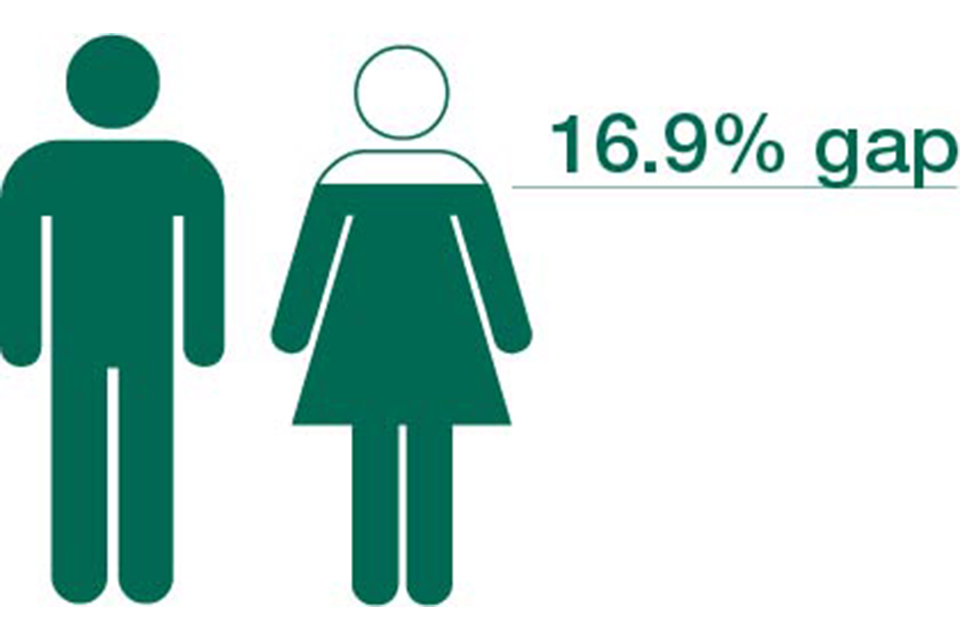
Mean pay gap

Median pay gap
Gender bonus gap

Mean bonus gap
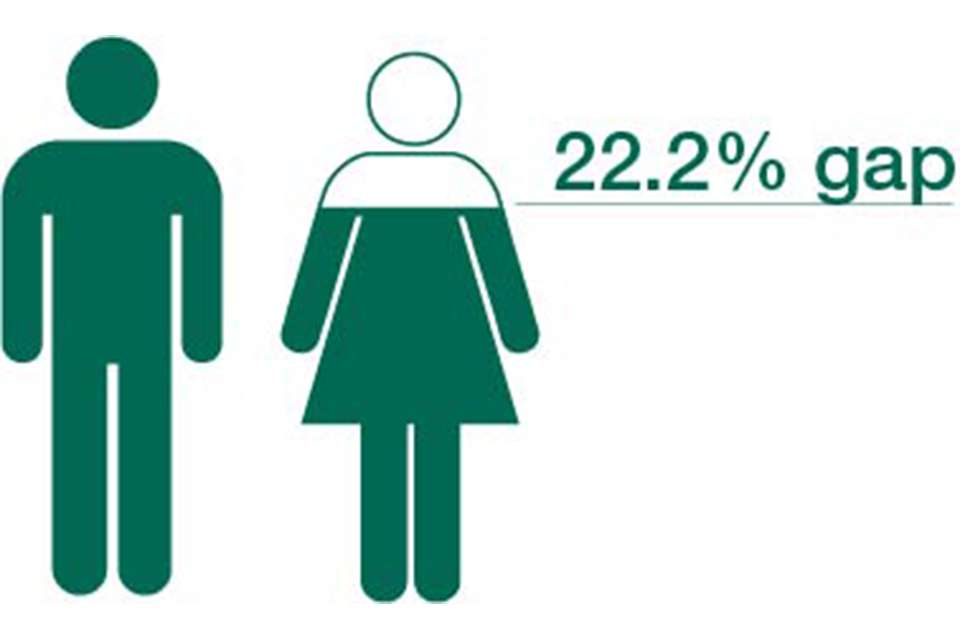
Median bonus gap
This data tells us that on average, men are paid 16.9% higher than women and receive 25.2% higher bonus payments (depending on which average methodology is being used). To understand why this gap exists, we need to look at some further information on the organisation and also the context in which it operates.
It is standard practice across DfT organisations for non-consolidated bonus payments to be pro-rated in accordance with number of hours worked by each employee. As a result, those working part-time, of whom the majority in DfT are female, will receive a lower bonus when compared to full-time employees.
As the value of non-consolidated bonuses increases with seniority of grade, and as there is a greater representation of male employees in the more senior grades, the average bonus for men will be higher than that for women.
In the central department, the balance of roles is more similar to other government departments than in our agencies. The focus is less on technical roles and this is seen in the gender pay and bonus gaps compared to those for the department as a whole. The mean pay of men in the central department is 9.9% higher than for women, and the mean bonus gap is -3.1% - the average bonus paid to women is 3.1% higher than that to men.
Why we have a gender pay gap
DfT group has an employee population made up of 44% women and 56% men, so the gap is unlikely to be a result of the gender diversity of the organisation in itself. We therefore need to look more closely at pay structures to understand what the other drivers are.
Pay and grading
In DfT we use Civil Service grades that vary according to the level of responsibility that staff have, ranging from administrative assistant (admin level) to senior civil servant (executive level). Each grade has an associated salary band - new starters are expected to start at the bottom of the pay range and progress over time, based on performance in the role. The information below shows a breakdown of gender by grade within DfT and across the Civil Service.
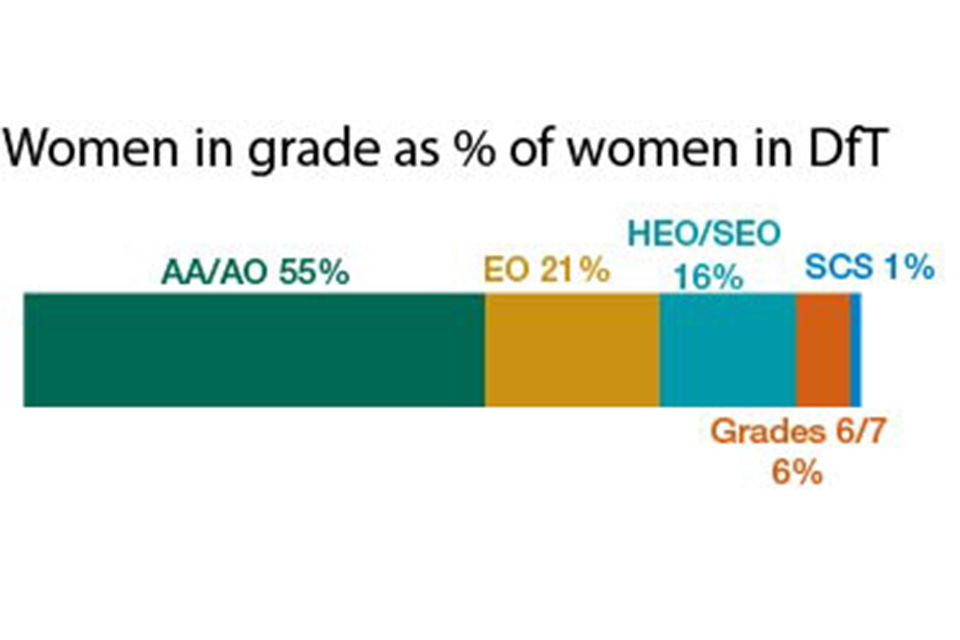
Women by grade at DfT
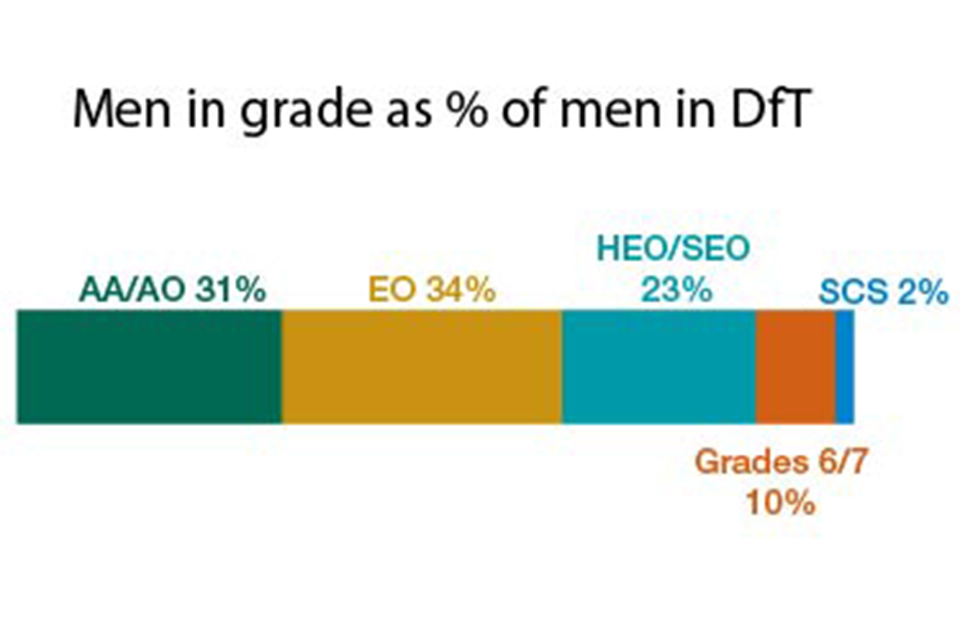
Men by grade at DfT
In DfT, we have a larger proportion of female employees in the more junior grades, and a larger proportion of male employees in the more senior grades. This is mainly due to the large numbers of female employees in administrative grades in DVLA, who as can be seen from Fig 1, are the largest employer in DfT. This does bring the average pay for women down and can go some way towards explaining the gender pay gap. In addition to this, as DVLA is based in Swansea, the large number of female staff there will be on the national pay bands, which are lower than that of London to reflect the difference in living costs.
Seeing the overall picture across the Civil Service, shown below, helps us to understand how our grade balance compares to the sector.
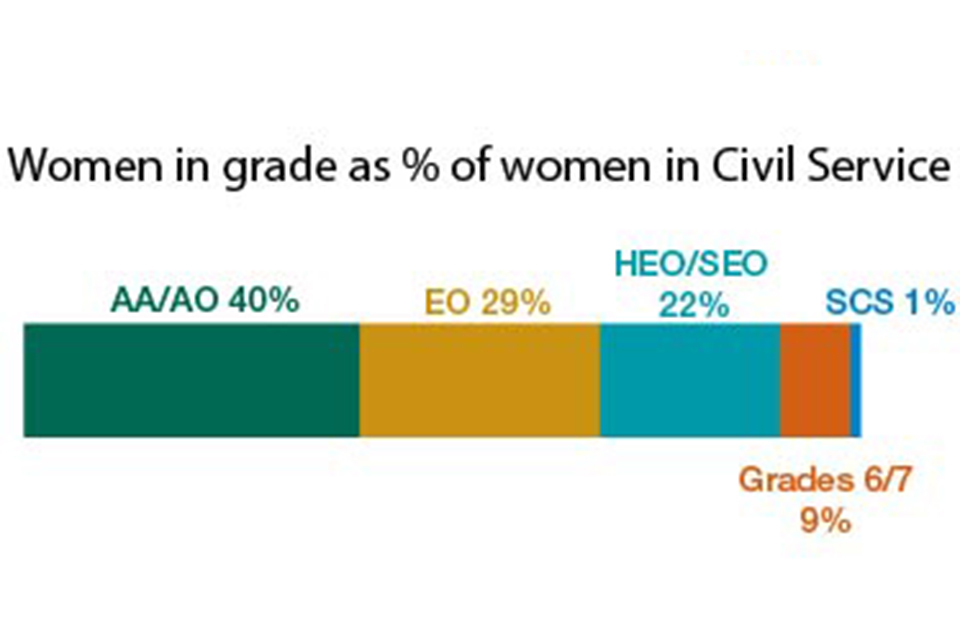
Women by grade Civil Service
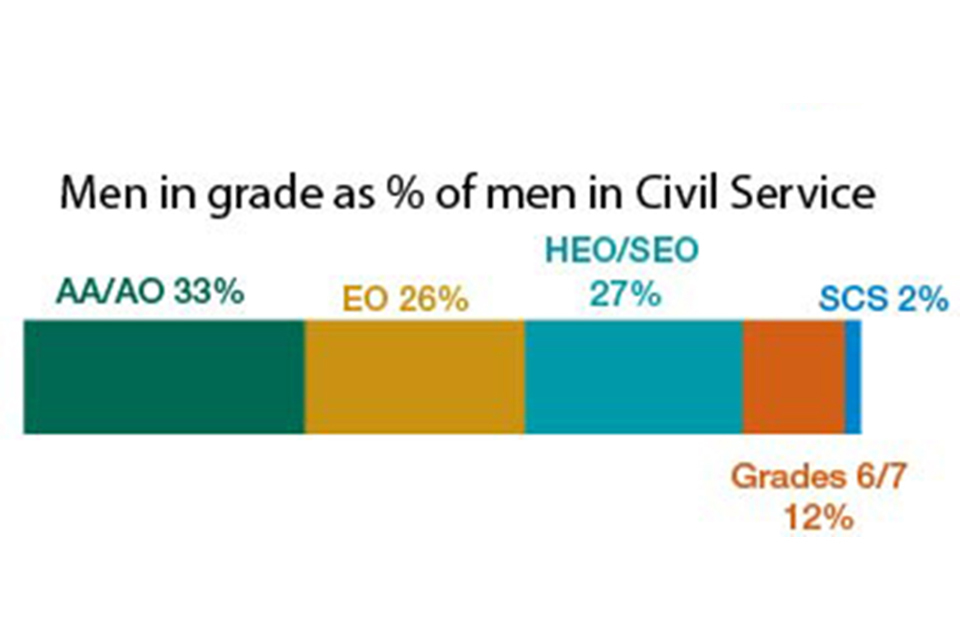
Men by grade in the Civil Service
Proportion of male and female employees in each pay quartile
To understand how the grade balance impacts pay, we split the proportions of male and female employees into quartiles, which is the gender split when the hourly rate of pay is ordered from lowest to highest and then grouped into 4 equal quartiles. Women make up two thirds of our lower pay quartile and approximately a third of the upper quartile.

Proportion of male and female employees in each pay quartile
An additional factor to consider here is the make-up of basic pay. Hourly rates include retention and technical allowances that are paid to employees with specialist, technical skills and expertise. In most cases these roles are occupied by men (for example, surveyors in the Maritime and Coastguard Agency and the vehicle standard assessors in DVSA) and this will therefore impact the gender pay gap further.
Proportion of male and female employees receiving a bonus (performance award) payment
Employees across all levels in DfT organisations are eligible for in-year and end year performance rewards depending on performance. Again, grade is a consideration in the levels of bonus paid, and the sums awarded are likely to increase with each grade.
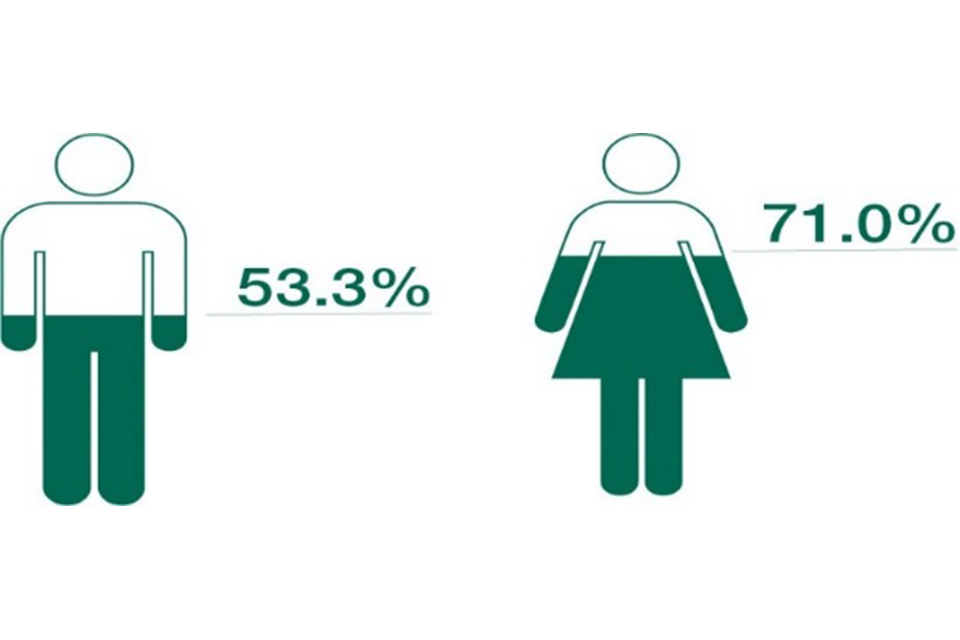
Proportion of male and female employees paid a bonus in the 12 months ending 31 March 2017
Although more women are receiving a bonus, as they are more likely to be at a lower grade, the average value they receive is less (illustrated above in the ‘Headline gender pay gap figures’ section), explaining the wide gender pay gap in relation to bonus.
Gender pay gap vs. equal pay
Whilst we do have a gender pay gap, we are confident that men and women are paid equally for doing equivalent jobs across the DfT Group, following an equal pay audit in 2015. The gender pay gap analysis gives us even more impetus to continue the work we are doing to encourage more women into the transport sector, especially at senior levels. We talk about how we are doing this later in the report, and we are clear that this is a long term goal that we are committed to seeing through so in time, the gender pay gap is reduced.
What we’re doing to tackle our gender pay gap
Our Permanent Secretary, Bernadette Kelly, is our Gender Champion, supported by thriving gender staff networks. Gender forms a central part of our recently launched diversity and inclusion strategy, which aims to make us one of the most inclusive departments in the Civil Service. In terms of gender, we are committed to moving toward gender parity in all grades, roles, and locations across the department. In order to achieve this we will continue to strengthen our female talent pipeline and senior leadership cadre.
Recruitment
We aim to recruit from the widest possible talent pool. As well as using name-blind recruitment, gender-diverse panels and staff panels (for senior recruitment), we are fundamentally reshaping the way we attract and recruit our workforce in a way that meets future skills needs and increases our diversity.
We’ve collaborated with Harvard Business School to understand how behavioural insights can help us attract more women into historically very male-dominated engineering roles in operational areas of our business. Barriers in recruitment, such as the wording of job adverts and not showing existing diversity within the workforce were recognised. The changes implemented in response to this in one of our agencies, the Maritime and Coastguard Agency, have led to a 5% increase in female applicants in less than a year, which is a truly impressive change for the better.
To reach out to under-represented groups, we are increasingly moving away from traditional advertising towards job boards specifically geared towards attracting diverse candidates and professional sites such as LinkedIn.
Long-term change
Change isn’t only for the short-term; we’re also embarking on initiatives to change the perception and culture of the department and the transport industry in the long-term.
The Secretary of State for Transport recently announced that the Year of Engineering is coming in 2018. This is a DfT-led campaign to inspire the next generation of engineers to tackle the engineering skills gap. Being proactive, government and industry are joining forces to give thousands of young people direct experiences as part of the Year of Engineering, with a particular emphasis on getting girls and their parents to consider engineering as a career. We’re also working with the charity Inspire the Future to encourage our people to visit schools and promote the Department of Transport as a great place to work and break down perception barriers, particularly amongst girls, about careers in transport.
Retention
It doesn’t stop at recruitment – once we’ve recruited great people, we want them to stay. We have several staff networks including four active Gender Networks, which support both women and men, a young families network and several carers networks.
Working flexibly
We support all staff who wish to work more flexibly and offer part time working, compressed hours, job-sharing and flexible working, supported by great IT. Ruth Hannant and Polly Payne job share the role of Director General Rail Group, acting as role models to demonstrate that people can progress irrespective of their working hours.
Development
We recognise that gender equality also relies on the development offer we can provide to our employees to support them to progress in their career. We have taken a keen interest in this area and have developed programmes and opportunities across the grades. We are an active participant in the civil service positive action pathway, a cross-government scheme for staff in under-represented groups, including women. In the Driver and Vehicle Licensing Agency, the crossing thresholds programme is a year-long career mentoring programme for women who want to develop their career, with the participants’ mentoring partnerships underpinned with group modules, peer support groups and individual assignments.
There is still much more for us to do. We are, and continue to, focus on the steps we can take and implement to build a more diverse and inclusive culture and organisation, not just in the short-term, but also for the longer-term, in order to ensure that our workforce represents the customer base we serve.
